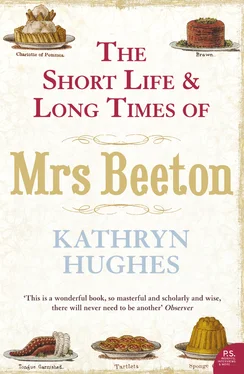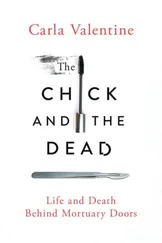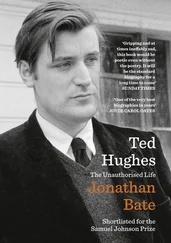So by the age of 30 Benjamin Mayson could be said to be doing rather well for himself. He was a vicar’s son and, though not quite a gentleman, was established in a gentlemanly line of business. Mayson, it is important to understand, was not a draper who stood behind a counter unrolling a yard or two of sprigged cotton for the approval of sharp-eyed housewives. He was a wholesaler, a merchant, a man who supplied the smarter kind of drapers with bulk orders and sealed deals with a handshake rather than a few warm coins. And it was a profitable business too. With the world getting both dirtier and more polite at the same time, there was a hunger for fresh linen. No one with any self-respect wanted to be seen in a smutty shirt or streaky dress. The middle-class wardrobe was expanding and becoming more particular, which was good news for anyone who supplied the materials to make all those clean sleeves and dainty collars. And, as if that weren’t enough bright fortune, Benjamin Mayson had arranged his private life carefully too. At an age when most men had already married, he was still a bachelor, having managed to avoid being jostled by loneliness or lust into a hasty match. He was, by anyone’s reckoning, quite a catch.
Elizabeth Jerrom, the woman whom Benjamin Mayson would marry, was born on 24 May 1815, three weeks before the great victory at Waterloo. Her parents Isaac and Mary were domestic servants, working for one of the big houses around Marylebone, part of that feverish development of gracious squares that had been built towards the end of the last century to house the newer aristocracy during the ‘London’ part of their wandering year. When the couple had married eleven months earlier at St Martin-in-the-Fields, they had signed the register clearly, confident in themselves and their new merged identity. The same, though, cannot be said of their witnesses. William Standage, Mary’s father, has done his best but the sprawling scratch he makes in the register is indecipherable: underneath the parish clerk has been obliged – tactfully, crossly? – to write out his name properly, for the record. Mrs Beeton is only twenty years away from people who would be happier signing themselves with a cross.
Mary Jerrom, Mrs Beeton’s grandmother and the only one of her grandparents who was to play a significant role in her life, had been born Mary Standage in 1794 in the ancient village of Westhampnett, just outside Chichester. Her father was a groom on the Duke of Richmond’s estate at nearby Goodwood. William Standage had himself been born 9 miles away, at Petworth where the huge Standage clan had for generations lived and worked with horses. The servants’ records at Petworth House show William’s father and brother driving ox and horse carts on the estate through the last decades of the eighteenth century. By 1811 another brother has a job looking after his lordship’s hunters. But it was William, born in 1763, who was the star of the stables. In 1792 he was headhunted by the horse-mad Duke of Richmond to work as a groom at Goodwood. Given that Mrs Beeton would be so exact about what you should pay your groom, it is nice to be able to report that in 1792 her great-grandfather was getting £18 a year which, by 1807, had risen to £24, with extra allowances for clothing and travel.
The horse was God at Goodwood. When the 3rd Duke of Richmond inherited in 1756 his first thought was not to rebuild the unimpressive house but to commission the architect William Chambers to build a magnificent stable block as a kind of love song to the most important creatures in his life. Complete with Doric columns and a triumphal arch, the block was home to the fifty-four lucky animals – hunters mainly, but from 1802 racers too. Family myth has it that it was William Standage who helped the Duke plot the track that would become one of the most important racecourses in the land. Whether or not this is strictly true, the story points up just what was important in this family. Horses are a recurrent presence in Mrs Beeton’s story, presiding spirits of events both happy and bad. Her grandparents will meet through them, her stepfather will make his fortune from them, her sister will lose an eye from one, while her first biographer and great-niece will fall out of the sky on the way to Aintree.
Standage, who married a woman called Elizabeth, produced a string of daughters: first Mary, next Sarah and then Harriet. All three girls married men who worked with horses. This is not as odd as it would seem today. You can only marry someone you’ve already met, and a groom’s daughter in the early nineteenth century met an awful lot of grooms. But none of the girls stayed in Sussex. Instead they followed the classic migratory pattern of their generation and poured into London, working first as servants in aristocratic mansions and then marrying men from the stables, men who knew or were known to their fathers. In time these men would set up as job masters or livery stable keepers, hiring themselves and their carriage out for a fee, doing for several families what they had formerly done for just one. By the end of the nineteenth century, you could still find the grandsons of these people working as omnibus and cab drivers, transporting restless crowds of shopgirls, clerks and housewives around a teeming central London.
Sometime around 1812 Mary came to London to work as a servant, and two years later she married 28-year-old Isaac Jerrom. Given that they married in St Martin-in-the-Fields, it looks like Isaac and Mary met while working in one of the aristocratic mansions around Piccadilly, quite possibly the London residence of the Duke of Richmond of Goodwood or Lord Egremont of Petworth. By the time their first baby Elizabeth – named for Mary’s mother – came to be christened the following year, Isaac and Mary ‘Jurrum’, as the parish clerk would have it, were living in Marylebone and gave their occupation as ‘servants’. Two years later, with the arrival of their new baby William, they are still describing themselves in the same unembarrassed way, tucked in amongst a dense urban parish swarming with labourers, gentlemen, shopkeepers, artists, clerks, peers, diplomats, musicians, and, of course, an army of domestic staff responsible for keeping this huge social beast trundling forward.
John Jerrom, Isaac’s father, who had probably migrated from Hampshire to London as a young man, now ran a livery stables in Marylebone. By 1820 Isaac starts to appear in the Marylebone rate books on his own account, running a stables just around the corner in Wyndham Mews, a newly built series of stables on the Portman Estate. Livery stables supplied carriages and drivers to those households who did not keep their own groom and horse. Most of the mansions in Marylebone had no need for this service since they were well able to make their own arrangements. Indeed, the status of a family was intimately tied up with the show it made in the streets, as it trotted around town in a carriage bearing its own insignia, driven by a couple of tall and handsome grooms. But there were households – often headed by women – who were happy to use freelance carriage services as and when they needed them. William Tayler, a footman in a Marylebone house in 1837, was edgy about the fact that his household, headed by a widow, used the services of a ‘jobber’. He knew exactly what it implied about the status of a household in which he was the only resident male servant.
Isaac and Mary Jerrom, released from the bonds of personal service, did well as small business people. The world was changing and they were quick to exploit its possibilities. People were on the move like never before and there was only so far a pair of sturdy legs could take you. As well as catering for the horseless mansions of Marylebone, Isaac provided a taxi service for its less exalted inhabitants, ferrying them around the rapidly extending city. In a classic combination, his wife Mary ran a lodging house, offering bed and board to all those bewildered new arrivals to London. Little by little Isaac rented adjoining properties in Wyndham Mews until in 1826, his high-water mark, the Jerroms were operating out of four separate properties – numbers 1, 4, 5, and 10. When extra manpower was needed, Isaac did the usual thing and turned to his extended family. In the mid 1830s he was joined in partnership by his younger cousin James Mitchell, a Londoner who turns up at all the key family events. Mitchell will be a witness at Elizabeth’s wedding in 1835 and, four years later, it is he who will inform the registrar of Isaac’s death from consumption.
Читать дальше












